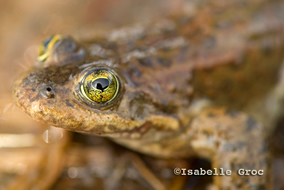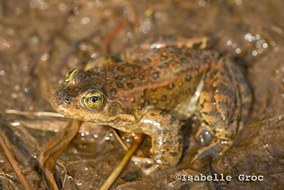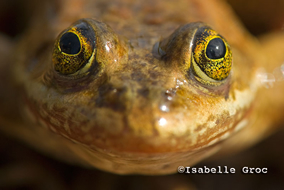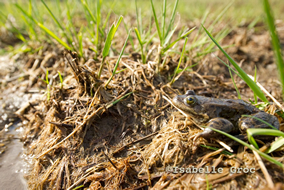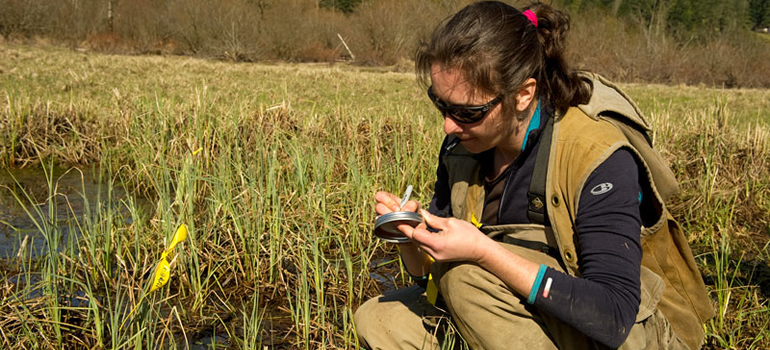
Monica Pearson wades into the chilly waters of the Fraser River to save Canada’s last 300 Oregon spotted frog breeding females
Monica Pearson is on an egg hunt – one that could save the most endangered amphibians in Canada.
The Oregon spotted frog – whose Latin name means “precious frogs” – has bright golden eyes and ranges in color from “Kermit green” to dark brown. They are shy, hide in tunnels and spend much of their time under water.
The federally endangered species is so rare that there are only an estimated 300 breeding females left in the country, and their habitat, confined to the Fraser Valley of British Columbia, is increasingly being encroached upon by humans and the invasive American bull frog. (See below)
From late February to mid-March, Pearson, a conservation biologist and Master’s student in Landscape Architecture, wades through chilly water along the Fraser River looking for egg masses in shallow pockets of wetland.
“The Oregon spotted frogs like to gather into a cluster and lay their eggs in the same spot,” says Pearson. “Because they literally lay all their eggs in one basket, they are extremely sensitive to environmental degradation and habitat loss.”
Oregon spotted frogs literally lay all their eggs in one basket, and they are extremely sensitive to environmental degradation and habitat loss.
On her egg hunt, Pearson meticulously counts the egg masses produced by single breeding females – each containing 500-1,200 eggs – and documents the location and environment around the masses. She also attaches radio telemetry belts to both spotted and bullfrogs to follow their tracks.
Then, like an architect building a dream home, Pearson envisages the ideal environment for the spotted frog – vegetation height, percentage of water, the presence of floating vegetation – down to the last centimetre.
“By determining what habitat the spotted frog is using and what the bullfrog is using, we can build restoration guidelines that favour spotted frogs and protect them from extinction.”
As it turns out, as little as 10 centimetres of water can make all the difference. Preliminary results from Pearson’s research suggest that the bullfrog prefers water deeper than 40 centimetres while the spotted frog likes water shallower than 30 centimetres. But these shallower waters are being lost.
Invasion of the alien frog
The American bullfrog, a much larger, aggressive species, is competing with the endangered Oregon spotted frog for food and territory. The bullfrogs, whose calls are to many the hallmark of summer, were first brought to B.C. from their native Ontario after the Second World War for a veterans employment program. Now they are used for classroom observation and often released into the wild. They are fierce predators but prefer slightly deeper water than the spotted frog – a factor that conservationists are incorporating into wetland restoration strategies.
“As humans, we like land, and we like water,” says Pearson. “The stuff in between we can’t walk on and we can’t swim or put a boat in. It’s uncomfortable to us and doesn’t seem particularly useful, so we either drain the water to make land, or we make the water deeper to make a pond.
“But wetlands – that in-between landscape – used to be habitats for thousands of ducks, fish, beavers, amphibians and mammals that we no longer see, and to me, the spotted frog is a symbol of what we’ve lost,” says Pearson, adding that more than 86 per cent of wetlands in the Fraser Valley has been lost to agriculture and housing.
“Wetlands also filter water, absorb carbon dioxide, reduce floods in the rainy season and release water in the dry season, providing enormous benefits to humans.”
Despite a lack of provincial laws to protect wetlands or endangered species like the spotted frog, Pearson is striving to rebuild their home. This summer, her recommendations will be used to restore a marsh in the Aldergrove Regional Park.
Her advice to fellow egg hunters?
“Pay attention to the water,” she says. “This time of the year you’ll find egg masses from all sorts of amphibians, keep your eyes open and remember that water and land sometimes belong together.”
Meet the Oregon spotted frog, visit http://youtu.be/fodijWVvPlY.
